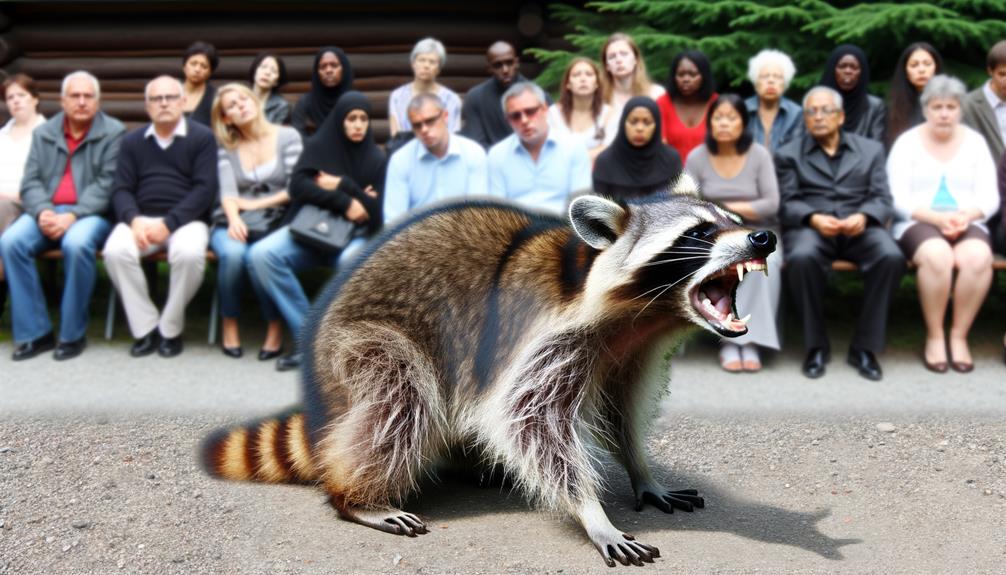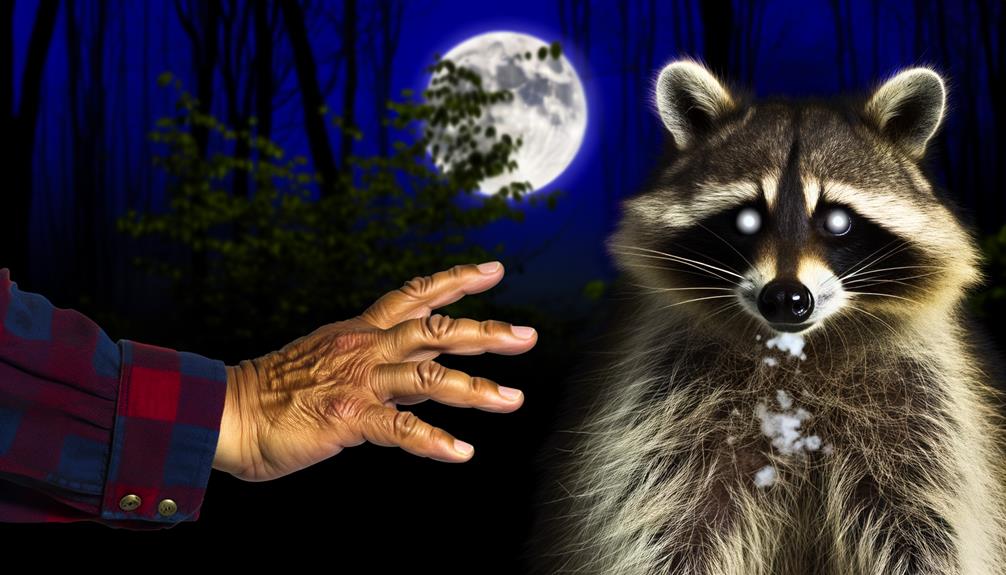How You Can Tell if a Raccoon Has Rabies – A Step-by-Step Guide
Identifying rabies in raccoons requires scrutinizing specific behavioral and physical symptoms. Key indicators include increased aggression, disorientation, and unprovoked attacks.
Observe for excessive drooling, frothing at the mouth, and marked vocal changes, such as growling or high-pitched screams, due to neural degeneration. Daytime activity in these typically nocturnal animals, combined with unusual tameness or heightened aggression, further signals potential rabies infection.
Approaching or handling suspected rabid raccoons is strongly discouraged; instead, contact local wildlife authorities for professional intervention. Detailed observation of these symptoms is critical for early detection and mitigating zoonotic transmission risks.
Continue to gain thorough insights into preventive measures and safety protocols.

Key Takeaways
- Look for aggressive behavior, such as unprovoked attacks or lack of fear towards humans.
- Observe for disorientation, staggering, or difficulty moving.
- Check for excessive drooling or foaming at the mouth.
- Listen for unusual vocalizations like growling, whining, or high-pitched screams.
- Note any unusual daytime activity in normally nocturnal raccoons.
Behavioral Changes

Frequently, raccoons infected with rabies exhibit significant behavioral changes, such as increased aggression, disorientation, and nocturnal activity during daylight hours. These behavioral alterations are indicative of the encephalitic phase of rabies, where the virus affects the central nervous system.
Clinical observations have documented that rabid raccoons may display unprovoked attacks and an unusual lack of fear towards humans. The disorientation is often reflected in aimless wandering and compromised motor coordination. Additionally, diurnal activity in this nocturnal species is a stark deviation from its natural behavior, signaling neurological impairment.
These behavioral symptoms are critical diagnostic indicators and necessitate immediate caution and intervention to mitigate the risk of transmission to humans and other animals.
Physical Symptoms
The physical symptoms of a raccoon infected with rabies often include marked signs of aggression and an abnormal increase in saliva production. Aggressive behavior may manifest as unprovoked attacks or unusual fearlessness.
Additionally, the presence of excessive saliva, or hypersalivation, is a key indicator of advanced rabies infection.
Aggressive Behavior Signs
Aggressive behavior in raccoons potentially infected with rabies often manifests through unprovoked attacks and a lack of typical fear towards humans and other animals. This altered behavior is a pivotal indicator, as rabies affects the central nervous system, leading to erratic and hostile actions. Clinically, infected raccoons might exhibit heightened irritability, growling, or biting without apparent provocation.
These behavioral changes are a deviation from the species' normal conduct, where caution and avoidance of human interaction are standard. The aggressive tendencies can escalate rapidly, making the raccoon a potential threat. Monitoring for these signs is essential, as they suggest neurological impairment consistent with rabies infection, necessitating immediate intervention by wildlife control professionals.
Excessive Saliva Presence
An increased presence of saliva, often seen as frothing or drooling, is a critical physical symptom indicative of rabies in raccoons. This condition, termed hypersalivation, results from the virus's impact on the animal's nervous system, leading to dysfunction of the salivary glands.
Clinicians and wildlife professionals can identify excessive saliva through the following observable signs:
- Persistent Drooling: Continuous saliva discharge, not associated with feeding or drinking.
- Foaming at the Mouth: Visible bubbles or foam around the mouth area, indicating advanced salivation.
- Difficulty Swallowing: Observable struggle to ingest food or water, often leading to further drooling.
These symptoms necessitate immediate caution and professional intervention to prevent potential transmission of rabies.
Vocalization Patterns

Identifying rabies in raccoons can be particularly challenging, yet vocalization patterns provide critical diagnostic cues. Infected raccoons often exhibit abnormal vocalizations, including excessive growling, high-pitched screaming, and unusual whimpering.
These auditory signals deviate significantly from the species' typical communication repertoire, which generally includes purring and chittering sounds. Research indicates that neural degeneration caused by the rabies virus directly impacts the central nervous system, leading to these aberrant vocal behaviors.
Clinical observations corroborate that rabid raccoons may also display heightened aggression and irritability, further contributing to their altered vocal output. Consequently, recognizing these unusual vocalization patterns can be instrumental in early rabies detection, facilitating timely intervention and management of potential public health risks.
Daytime Activity
Daytime activity in raccoons can be an indicator of rabies, as these nocturnal animals typically avoid daylight.
Rabid raccoons may exhibit unusual behavior patterns, such as increased aggression towards humans and other animals.
Additionally, a lack of coordination, evidenced by stumbling or erratic movements, is commonly observed in infected individuals.
Unusual Behavior Patterns
Observing a raccoon active during daylight hours can be a critical indicator of potential rabies infection, as these nocturnal animals typically avoid daytime activity. Rabies can alter the neurological function of raccoons, leading to aberrant behavior patterns, which are essential to recognize for public health safety.
Key unusual behaviors include:
- Disorientation: Raccoons may exhibit signs of confusion or lack of coordination, such as walking in circles.
- Lethargy: Infected raccoons might appear unusually sluggish or unresponsive, contrasting their normal alertness.
- Unprovoked Vocalization: Increased vocal activity, including growling or screeching without an apparent trigger, can be observed.
Identifying these behaviors promptly can facilitate timely intervention and prevent potential transmission of rabies to humans or pets.
Aggression Towards Humans
Aggressive behavior towards humans during daylight hours is a notable clinical sign of rabies in raccoons, necessitating immediate caution and intervention. Typically nocturnal, healthy raccoons avoid human contact and activity during the day.
However, rabid raccoons display heightened aggression, characterized by unprovoked attacks, snarling, and biting. This aberrant behavior is due to the viral invasion of the central nervous system, which leads to neurological impairment and heightened excitability.
The presence of such aggression, particularly in daylight, strongly indicates rabies infection, as the virus alters normal circadian and behavioral patterns. Immediate reporting to local animal control or public health authorities is critical to mitigate the risk of transmission and prevent potential human exposure to this fatal zoonotic disease.
Lack of Coordination
A marked lack of coordination in raccoons, particularly when observed during daylight hours, is a significant clinical sign of rabies infection. Rabies affects the neurological system, impairing motor functions and resulting in unsteady movements. Key indicators include:
- Ataxia: Exhibiting a lack of muscle control or coordination of voluntary movements, such as walking or reaching.
- Disorientation: Demonstrating confusion or an inability to navigate familiar environments.
- Tremors: Experiencing involuntary shaking that affects the raccoon's ability to maintain balance.
These symptoms are exacerbated by the fact that raccoons are nocturnal animals; daytime activity alone is abnormal and warrants concern. Prompt reporting to local animal control can aid in managing potential rabies outbreaks and ensuring public safety.
Approachability

One indicator of rabies in raccoons is a marked change in their approachability, often manifesting as unusual tameness or aggression towards humans. Rabid raccoons may exhibit a drastic reduction in their natural wariness, becoming unexpectedly docile or overly bold.
This behavioral anomaly can be attributed to the progression of the rabies virus, which affects the central nervous system, impairing normal fear responses and self-preservation instincts. Conversely, heightened aggression can occur, characterized by unprovoked attacks on humans or other animals.
Such atypical behaviors are significant red flags, given that raccoons generally avoid human interaction. Recognizing these changes in approachability is essential for early identification of rabies, thereby mitigating potential exposure risks and enabling timely intervention.
What to Do
Upon identifying abnormal behavior in a raccoon that may indicate rabies, immediate action must be taken to safeguard safety and proper handling of the situation.
The following steps are recommended:
- Avoid Contact: Do not approach or try to capture the raccoon. Rabies is highly transmissible through bites or scratches.
- Notify Authorities: Contact local animal control or wildlife services immediately. They are equipped to handle potentially rabid animals safely.
- Secure the Area: Confirm pets and children are kept indoors and away from the raccoon. This minimizes the risk of transmission and allows professionals to intervene.
Conclusion
To sum up, coinciding symptoms such as erratic behavioral changes, distinct physical symptoms, altered vocalization patterns, unusual daytime activity, and increased approachability serve as critical indicators of rabies in raccoons.
These signs, when observed collectively, strongly suggest the presence of the virus.
Prompt identification and appropriate action, including contacting wildlife authorities, are essential to mitigate the risk of transmission and guarantee public safety.
The convergence of these symptoms underscores the importance of vigilance in monitoring wildlife health.






